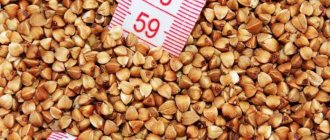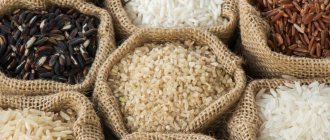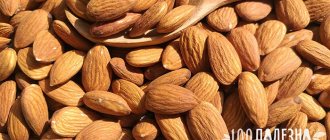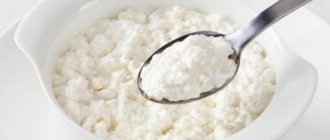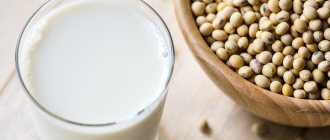Buckwheat is a cereal obtained from grains of seed buckwheat (an annual cereal of the Buckwheat family). The plant's homeland is the mountain slopes of India, Burma, Nepal, from where it spread across the globe. The cereal “came” to European countries from Greece.
The product is used in cooking to create a side dish for vegetable and meat dishes, casseroles and snack pies. In addition, buckwheat has found wide application in medicine: it prevents vitamin deficiency (especially in the spring and winter), strengthens the walls of blood vessels, improves immunity, activates the intestinal tract, and stabilizes the psycho-emotional background.
General information
Buckwheat is considered an environmentally friendly product, since its cultivation technology does not require the addition of chemicals during sowing. The cereal is cultivated primarily for culinary purposes. However, thanks to its rich chemical composition, cereals are popular in diet therapy, medicine, cosmetology, and agriculture.
The following types of buckwheat are distinguished:
- kernel (whole grain, peeled from the outer shell);
- prodel or chaff (crushed cereal with a broken structure);
- Smolensk flakes (highly crushed grains).
Classification of buckwheat by type of heat treatment:
- fried (dark brown);
- steamed (brown);
- natural (light green).
Remember, the smaller and darker the cereal, the fewer nutrients it contains.
What about carbohydrates?
Many of you may ask the question, how can buckwheat help you lose weight or improve your health when it contains so many carbohydrates in any form, boiled or raw. After all, they say everywhere now that if you want to be slim, then no carbohydrates. And even more so, they affect the deposition of fat, especially on the hips and abdomen, and cause cellulite. Yes, you are right, besides, carbohydrates can cause a sharp jump in blood sugar levels, which is contraindicated for diabetics. There can be no talk about health and weight loss here. Only this effect is caused by fast carbohydrates, and buckwheat is a complex or, as they also say, slow type of carbohydrates.
Such complex carbohydrates are represented by coarse fibers or cellulose in cereals. These substances give a feeling of fullness for a very long time; they are not completely absorbed by the body, but cleanse the gastrointestinal tract, freeing our body from harmful accumulations. As a result, our metabolism and digestion are normalized, weight begins to gradually decrease, and, in general, our appearance becomes more attractive.
Chemical composition
Buckwheat is the record holder for protein content among cereals. The biological value of the crop protein is determined by the 18 amino acids present in the cereal. The highest concentrations are found in lysine, tryptophan, arginine, methionine, valine, isoleucine, and glycine.
Interestingly, in terms of protein content, buckwheat is a complete alternative to animal protein.
To supply the body with building materials, it should be present daily in the menu of athletes, vegetarians, pregnant women, and the elderly. Table No. 1 “Chemical composition of buckwheat”
| Item name | Ingredient content in 100 grams of cereal, milligrams |
| Vitamins | |
| Tocopherol (E) | 6,65 |
| Niacin (PP) | 4,2 |
| Riboflavin (B2) | 0,2 |
| Pyridoxine (B6) | 0,4 |
| Thiamine (B1) | 0,43 |
| Folic acid (B9) | 0,032 |
| Beta-carotene (A) | 0,002 |
| Macronutrients | |
| Potassium | 380 |
| Phosphorus | 298 |
| Magnesium | 200 |
| Sulfur | 88 |
| Chlorine | 33 |
| Calcium | 20 |
| Sodium | 3 |
| Microelements | |
| Silicon | 81 |
| Iron | 6,7 |
| Zinc | 2,03 |
| Manganese | 1,56 |
| Copper | 0,64 |
| Bor | 0,35 |
| Titanium | 0,034 |
| Molybdenum | 0,033 |
| Fluorine | 0,023 |
| Nickel | 0,0101 |
| Selenium | 0,0083 |
| Chromium | 0,004 |
| Iodine | 0,0033 |
| Cobalt | 0,0031 |
The nutritional value of buckwheat includes (per 100 grams):
proteins – 13.5 grams;- fats – 3.4 grams;
- carbohydrates – 61.5 grams;
- water (14 grams);
- organic acids (0.2 grams);
- dietary fiber (11.3 grams);
- starch (55.4 grams);
- unsaturated fatty acids (2.28 grams);
- mono- and disaccharides (1.5 grams);
- saturated fatty acids (0.67 grams);
- amino acids (10.32 grams);
- sterols (0.074 grams)
- ash (2.1 grams);
- purines (0.06 grams).
The calorie content of a product directly depends on the cooking method. Thus, dry (sprouted) grain contains 330 kilocalories per 100 grams of product, boiled cereal - 150 kilocalories, steamed kernels - 250 kilocalories.
Considering that the cereal does not contain gluten (gluten), buckwheat provides special value for people suffering from celiac disease.
Proteins, fats and carbohydrates in cereals and porridge
How many proteins, fats and carbohydrates are in the cereal can be seen in the table “BJU Buckwheat”:
| Component name | Amount in 100 grams of boiled buckwheat | Amount in 100 grams of dry buckwheat |
| Squirrels | 3,6 | 12,6 |
| Fats | 2,2 | 3,3 |
| Water | 72 | 15 |
| Carbohydrates | 17 | 57 |
| Cellulose | 1 | 11,3 |
The energy value of buckwheat is 313 kcal in dry cereal and 132 kcal in buckwheat porridge with water and a little salt.
Carbohydrates
Dairy-free buckwheat porridge is the main dish in many diets, allowing you to lose weight, remove waste and toxins from the body, and improve the condition of blood vessels. This is explained by the fact that cereal contains a large amount of carbohydrates, which nutritionists classify as complex carbohydrates. They digest slowly, give you a feeling of fullness and quickly satisfy your hunger.
How much carbohydrates buckwheat contains depends on the type of cereal: cooked or dry. 100 g of buckwheat contains about 57 g of the substance, and porridge - about 17 g. The nutritional value of buckwheat decreases due to an increase in the volume of grains during heat treatment. Another advantage of cereals is the absence of sugar, gluten and starches.
Squirrels
If you eat cereal regularly, your body will not experience a deficiency of protein and amino acids. How much protein is in buckwheat:
- boiled (in 100 g) - 3.4 g;
- dry (100 g) - 13 g.
The high protein content and its composition explain the need for buckwheat porridge in the nutrition of athletes, as well as during recovery after operations, illnesses, and injuries.
Fats
The benefits of cereals for the body lie not only in slow carbohydrates and high protein content, but also in the absence of cholesterol. In dry cereals there is no more than 3 g of fat per 100 g of product, and in boiled cereals (in water) - no more than 2 g. Of the monounsaturated and polyunsaturated kernels, the kernels contain:
- 0.9 g linoleic acid;
- 1 g oleic acid;
- 0.1 g linolenic acid.
Vegetable fats have a beneficial effect on weight loss because they help cleanse the body and accelerate metabolic processes.
Beneficial features
The effect of cereal on the human body:
Reduces the risk of developing malignant tumors (due to the content of natural antioxidants).- Increases the body's resistance to adverse environmental factors, including radiation (folic acid strengthens the immune system, potassium and iron prevent the absorption of radioactive isotopes).
- Accelerates the healing of the gastric mucosa (tannins contained in cereals have an anti-inflammatory effect).
- Potentiates the synthesis of hemoglobin, as a result of which the rheological parameters of the blood improve (due to the presence of iron).
- Prevents the occurrence of thrombosis (unsaturated fats prevent the adhesion of cholesterol plaques to the walls of blood vessels).
- Improves psycho-emotional state, prevents sleep disorders (due to the presence of tryptophan, magnesium, B vitamins).
- Stabilizes blood sugar concentrations (has a low glycemic index of 40).
- Prevents hormonal dysfunctions by supplying the body with essential substances (vitamins, amino acids, micro- and macroelements).
- Increases potency in men (zinc stimulates testosterone production).
- Reduces blood pressure, normalizes the contractile function of smooth muscles (magnesium controls these processes).
- Strengthens the nervous and immune systems, helps in the fight against insomnia, migraines, headaches (thanks to the presence of rutin and B vitamins).
- Stimulates intestinal motility, relieves constipation, and “supplies” dietary fiber to the body.
- Seals the walls of blood vessels, increases the elasticity of veins (rutin, which is rich in cereals, has a pronounced capillary-protective effect).
- Strengthens bone tissue, including teeth and nails (due to the phosphorus and calcium content).
- Maintains osmotic pressure in the cell, accelerates the removal of excess fluid from the body (these mechanisms are “under the control” of potassium).
- Stabilizes heart rhythm, improves myocardial function, prevents the development of coronary disease (magnesium contained in buckwheat normalizes the neuromuscular activity of the heart).
- Protects the liver from fatty infiltration (due to the presence of lipotropic substances in the cereal).
In addition, with regular consumption of buckwheat, the functional state of the dermis, hair, and nails improves.
Harm of buckwheat and contraindications for use
The benefits and harms of buckwheat for the human body are largely determined by the amount of the product. The recommended daily intake for a healthy person is about 200 g. Buckwheat in the morning will be especially beneficial; it activates the metabolic system and will help you get a boost of vivacity and energy.
Certain ailments require increased attention to diet. In this regard, it is necessary to figure out whether it is possible to eat cereals with certain diseases.
Since buckwheat consists of slow carbohydrates and contains little sugar, the level of glucose in the blood after eating cereal rises slowly and slightly. The cereal also contains magnesium, and this element is necessary for the prevention and treatment of diabetes.
For diabetics, cereal is included in the permitted products. However, doctors recommend reducing the daily dose slightly, for example, buckwheat for breakfast in the amount of 100-150 g.
For pancreatitis
In case of acute inflammation of the pancreas, patients are advised to refuse any food and wait until the pain subsides. About 7 days after the exacerbation ends, buckwheat porridge can be returned to the diet. However, it needs to be cooked in a special way - it should be as soft as possible, having been soaked for a long time.
Boiled buckwheat will bring benefits for pancreatitis if you take crushed cereal or boil whole grains longer than usual. When the porridge is completely ready, the grains will need to be removed, ground into a homogeneous puree and returned to the liquid; such a dish will not harm the irritated pancreas.
Important! After acute pancreatitis, buckwheat porridge can only be consumed without butter, salt and sugar.
It is not recommended to supplement it with milk - buckwheat should be absolutely dietary, without any additives.
For gastritis
In case of an acute attack of gastritis, it is recommended to abstain from buckwheat. But 2-3 days after the onset of the attack, you can boil liquid porridge. Buckwheat soaked in water overnight will be beneficial if you then boil it, keeping it on the fire a little longer than usual. It is not recommended to add salt and oil to porridge; they can cause harm to an inflamed stomach.
The only contraindications to consuming buckwheat are individual intolerance and allergic reactions. But along with this, there are a number of restrictions associated with including this product in your diet:
- It is not recommended to cook buckwheat porridge with milk, since the cereal is rich in iron, and milk is rich in calcium. These minerals, entering the body at the same time, are practically not absorbed, which negates the benefits of the dish.
- You should not get carried away with buckwheat mono-diets. Even such a healthy product as buckwheat, in large quantities, can lead to digestive disorders, which will temporarily lead to weight loss, but can result in more significant problems.
Buckwheat is a valuable product in terms of its vitamin and mineral composition, for which it is impossible to find an analogue with the same content of amino acids, micro- and macroelements.
Application in medicine
Considering that buckwheat contains a wide range of useful substances, it is successfully used in folk medicine. To prepare medicinal potions, whole, unroasted cereal grains (green), as well as leaves and shoots of buckwheat, are used.
Traditional recipes:
A mixture for stagnation of bile, high sugar, pancreatitis, poisoning. To prepare the composition you will need 15 grams of buckwheat flour and 250 milliliters of low-fat kefir. The first ingredient is obtained by grinding cereals in a coffee grinder, and the second is obtained by fermenting homemade milk. Both products are combined and left in the container overnight. The resulting mixture is eaten for breakfast. The duration of choleretic therapy is 1 month. After 30 days the course is repeated.- A remedy for anemia, chronic fatigue, weakness. Before creating the potion, the cereal is washed and then dried in a frying pan. After this, the kernel is ground in a coffee grinder. Buckwheat flour is taken 30 grams 4 times a day, in between meals.
To enhance the therapeutic effect, the powder is washed down with warm milk. Use the product for at least 30 days (until the condition improves). If necessary, after a month's break, the course is repeated.
- Buckwheat jelly to strengthen the cardiovascular system and prevent atherosclerosis. The composition of the healing product includes 45 - 50 grams of cereal (pre-crushed in a coffee grinder), 250 milliliters of water. Combine these ingredients and mix thoroughly. After this, the mixture is poured in a thin stream into a liter of boiling water. The jelly is simmered over low heat for 10 minutes. Take buckwheat mixture 3 times a day, 200 milliliters.
- Healing ointment for abscesses, boils, and difficult-to-heal wounds. Crushed buckwheat (45 grams) is combined with a decoction of celandine (50 milliliters). The healing mixture is applied to the affected area three times a day for 10 minutes.
- Buckwheat sprouts for healing the body. The grain is rinsed with clean water and then placed on damp gauze. The container with the raw materials is placed on the windowsill. Considering that green buckwheat secretes a lot of mucus, the fabric and cereal are washed daily with water. With proper care, seedlings appear on the 2nd day. For medicinal purposes, slightly “hatched” grains (1–4 millimeters) are used.
Remember, the length of the sprouts should not exceed 1 centimeter.
Indications for use: anemia, obesity, vitamin deficiency, inflammation of the gallbladder, arthritis, pathologies of the organs of vision, atherosclerosis, coronary heart disease, varicose veins.
- Powder for babies. The crushed buckwheat kernels are sifted through a fine sieve. The resulting powder is used for the prevention and treatment of diaper rash in children (in the absence of lycopodium).
Interesting Facts
Scientists consider India to be the birthplace of such a popular product. Initially, buckwheat had a different name - “black rice”. Over time, the cereal found its way to Greece, where the “conquest” of the entire European continent began. At the same time, the name of the product was given by the Scythians, who bought it from the Greeks. Hence the name - “buckwheat”.
An interesting fact is that the mentioned name took root only in the CIS countries, while in Europe buckwheat is called “Arab grain”. In terms of popularity, the product is in no way inferior and is consumed at the same level as rice.
Recently, the practice of sowing buckwheat fields near apiaries has been popular, which produces buckwheat honey that tastes good. In the North (Siberia), buckwheat flour is most in demand, which is used for baking pancakes and pies.
Application in cosmetology
Buckwheat, along with improving the health of the body, has a beneficial effect on the skin (nourishes, rejuvenates, cleanses, normalizes cellular metabolism). Due to the content of vitamins, phytohormones, organic acids and fats, the cereal is actively used in professional cosmetics, as well as homemade masks, creams and scrubs. Homemade mixtures with buckwheat are ideal for caring for combination, normal, and sensitive skin.
Cereal based home remedies:
Nourishing mask for dry and normal skin. Ingredients: 30 – 60 grams of buckwheat flour, 20 milliliters of olive oil. The mask is applied to previously cleansed, damp skin of the face, neck and décolleté for 20 – 30 minutes. After completing the procedure, the mixture is washed off with warm water.- Toning mask for oily and combination skin. Method of preparation: mix grated carrots (1 piece), 30 grams of buckwheat flour, 2 milliliters of lemon juice. Apply the paste mixture to the dermis for 20 minutes, rinse.
With regular use of the composition (three times a week), the complexion improves, the capillaries are strengthened, and the oily sheen disappears.
- Film mask for problematic and sensitive skin. To prepare the product you will need 100 milliliters of chamomile infusion. 15 grams of edible gelatin and 20 grams of buckwheat flour are dissolved in it. The prepared mixture is heated to 70 degrees and then cooled. After this, add 15 milliliters of fresh aloe juice (or cucumber) to the mask. Leave the mixture on your face for 20 minutes and then carefully remove it with your hands. A film mask is used to cleanse and narrow pores, reduce acne, activate blood circulation, and deeply moisturize the dermis. It is suitable for all skin types.
- Mask against rosacea. Active components of the composition: buckwheat flour (15 grams), chicken yolk (1 piece), honey (5 milliliters). The ingredients are thoroughly mixed and applied to the dermis in a thin layer. After 15 minutes, the mixture is washed off. The mask has a capillary-protective, anti-inflammatory and strengthening effect on the skin.
- Compresses for eyes against swelling. Buckwheat is pre-crushed and distributed into two gauze bags. Before use, immerse them in hot water for 4 minutes (to steam), then cool. After this, apply compresses to your eyelids for 15 minutes.
This mask is used to eliminate puffiness under the eyes, smooth out fine wrinkles, and deeply nourish the dermis.
- Body Scrub. Buckwheat flour (15 grams), coffee grounds (15 grams), mint or chamomile infusion (100 milliliters) are combined and stirred thoroughly. The mixture is applied to a washed body, intensively massaging problem areas.
The scrub perfectly removes dead skin cells of the epidermis, cleanses and tones the skin, and reduces the severity of cellulite.
- Nourishing hair mask. To create the mixture, prepare: 30 grams of buckwheat flour, 100 milliliters of warm homemade milk, 1 egg, 10 milliliters of honey. The composition is mixed and applied to clean hair for 30 - 40 minutes. After the specified time, wash off the mask with hot water and shampoo. The product nourishes and strengthens thin, unruly hair.
To enhance the cosmetic effect, after completing the procedures, a nourishing cream is applied to the skin.
Properties and benefits for the body
Many people are interested in the question: what are the benefits of buckwheat for the body, and why should it be consumed regularly? We will answer these questions.
Buckwheat helps improve metabolism
Despite its rather high calorie content (310 kcal/100 g), buckwheat is indispensable for weight loss, if only because it helps to increase the level of basal metabolism, and this effect allows you to burn much more calories than those we get from buckwheat. The high fiber content and lower content of easily digestible carbohydrates means that only a small amount of carbohydrates increases blood sugar levels and is thus included in fat metabolism.
In Russia and Ukraine, buckwheat has become the basis of nutrition. In addition to everyday nutrition and public catering (even in a run-down restaurant there is always a side dish of buckwheat porridge), buckwheat is actively used as an indispensable product of therapeutic and dietary nutrition.
For what diseases are buckwheat dishes required?
Atherosclerosis, liver diseases (hepatitis, hepatosis, cirrhosis), hypertension of various origins (except renal), edema, increased cholesterol levels in the blood, immune system disorders, constipation, gastritis and peptic ulcers - this is an incomplete list of diseases for which it is recommended to use eating buckwheat dishes. Diseases of civilization - decreased immunity, poisoning by industrial toxins, chronic stress, chronic fatigue syndrome - have become the reason why nutritionists recommend actively introducing buckwheat and dishes made from it into the diet. Many researchers point to the benefits of buckwheat for osteoarthritis (joint damage), note its detoxifying, strengthening effect on capillary walls and the ability of buckwheat to increase dopamine levels (i.e., helps overcome depression, especially in men).
Mustard wraps for weight loss and cellulite
Buckwheat for weight loss
Despite its high energy value, buckwheat has a low glycemic index. This is an absolutely dietary product on the basis of which many weight loss plans, fasting days and food rations have been compiled.
The effectiveness of buckwheat diets is due to the prolonged breakdown of the grain in the stomach, which dulls feelings of hunger. At the same time, the body is forced to provide itself with nutrients by burning fat reserves from the depot. As a result, metabolism accelerates and a person loses excess weight faster. In addition, cereal contains many useful elements that help a person lose weight while maintaining a good mood, strong nails, healthy skin and thick hair.
The buckwheat diet is easy to use, as it contains cereals and water. The duration of mononutrition varies from 3 to 14 days (depending on the goals). A three-day weight loss regimen is classified as fasting days; it helps the body cleanse itself of toxins and burn up to 1.5 kilograms of excess weight. To eliminate 5 to 10 extra pounds, the buckwheat diet is extended to 14 days.
How to cook cereal correctly?
Buckwheat is steamed in the evening for the entire next day. To do this, 300 grams of washed kernels are poured with a liter of boiling water. The vessel is wrapped in a blanket and left on the stove for 10–12 hours.
Remember, adding sugar, salt or seasonings to a dietary dish is strictly prohibited.
If the mono-diet is poorly tolerated, it is recommended to use a milder version of the technique: include kefir in the diet.
Acceptable power schemes:
- Pour 350 grams of buckwheat with a liter of low-fat kefir. Leave the porridge for 10 – 12 hours in a warm place. Throughout the day, consume only the resulting mixture.
- In the morning, lunch and evening, eat exclusively steamed buckwheat, and during snacks, consume 250 milliliters of low-fat kefir. The daily intake of fermented milk drink is 1 – 1.5 liters.
The duration of the kefir-buckwheat menu should not exceed 14 days.
To consolidate the result, return to your previous diet gradually. In the first 4 days of the “exit”, in addition to buckwheat, eat only easily digestible foods (fruits, low-calorie yogurt, kefir, honey, vegetable salads, greens), and then gradually increase the calorie content of the diet to normal.
Contraindications to the use of the buckwheat diet: gastritis, stomach ulcers, duodenal erosion, diabetes mellitus, intestinal disorders, hypertension, pregnancy, lactation, old age and adolescence.
Carbohydrate ratio
| Monosaccharides (sugars): | |
| Glucose | n/a |
| Fructose | n/a |
| Galactose | n/a |
| Disaccharides (sugars): | |
| Sucrose | n/a |
| Lactose | n/a |
| Maltose | n/a |
| Total sugars | n/a |
| Polysaccharides: | |
| Cellulose | 10.30 g |
| Starch | n/a |
* - due to the separate study of carbohydrate fractions and the variability inherent in the measurement process, the final amount may not coincide with the amount of carbohydrates in the product
n/a - no research data available
How is buckwheat different from other cereals?
The main difference between buckwheat and other cereals is that it is not a cereal crop at all (like wheat, rice or corn), but, in fact, the seeds of the buckwheat flower. That is why buckwheat protein does not contain gluten, which causes food allergies, unlike the aforementioned wheat. In addition, buckwheat is rich in natural antioxidants that are not typical for other cereals.
Scientific research shows that the phytonutrients contained in buckwheat can influence the synthesis of insulin in the body, normalizing metabolic processes and helping to fight not only excess weight, but also type 2 diabetes.
All this makes buckwheat an indispensable element of a healthy diet and an important component of a weight loss diet.
Did you know that protein from buckwheat and beans is only 50-60% digestible? Tables of the percentage of protein absorption from food.
Health benefits of buckwheat amino acids
The amino acid lysine contained in buckwheat is involved in the formation of collagen, a structural element for the restoration of damaged body tissues - from the skin to internal organs. Lysine deficiency negatively affects protein synthesis, leads to fatigue and general weakness, as well as a decrease in muscle mass (especially on a diet).
Another amino acid contained in buckwheat, threonine, is needed to maintain effective muscle function and growth after strength training, as well as for the synthesis of immune proteins and digestive enzymes. The third important amino acid, tryptophan, is necessary for the synthesis of serotonin - tryptophan deficiency quickly leads to the development of depression.
Buckwheat and phytonutrients
Unlike any other cereal, buckwheat contains a strong natural antioxidant - vitamin P (rutin). This vitamin improves blood circulation, reducing capillary fragility and enhances the level of iodine absorption. In addition to buckwheat, this vitamin is found only in olives, asparagus and raspberries. It is simply not found in wheat, rice, corn and lentils.
Buckwheat also contains phytonutrients such as propelargonidins, prosyanidins and chiroinositol (2). The first two are known in traditional Chinese medicine as agents that have a positive effect on bone strength and the health of the musculoskeletal system, and chiroinositol is an element that affects the synthesis of glucose in the body.
Buckwheat on a diet and for diabetics
Scientific research shows that in obese diabetics, chiroinositol improves the body's overall sensitivity to insulin (3) - with regular use of this substance, the body begins to better use the energy of carbohydrates and simple sugars, using their calories for routine metabolism, rather than sending them to fat reserves.
Normalizing chiroinositol levels leads to improved tissue sensitivity to insulin, equalization of blood pressure and normalization of free testosterone levels in the blood. In fact, this confirms the well-known traditional recommendation for the use of buckwheat in diabetic and dietary nutrition (4).
***
Despite the fact that the calorie content, glycemic index and composition of basic vitamins in buckwheat are very close to all other cereals, none of them contains chiroinositol and vitamin P - phytonutrients that affect insulin levels and improve the body's mechanisms for using energy from simple carbohydrates.
- Buckwheat: Nutrition Facts, source
- Identification of galloylated propelargonidins and procyanidins in buckwheat grain, source
- Myo-inositol vs. D-chiro inositol in PCOS treatment, source
- Ovulatory and Metabolic Effects of d-Chiro-Inositol in the Polycystic Ovary Syndrome, source
How to prepare buckwheat jelly
A very useful product is buckwheat jelly, which is made from finely ground buckwheat flour. Kissel can be prepared this way: grind buckwheat in a coffee grinder, 3 tbsp. Dilute tablespoons of the resulting flour into 1.5 cups (300 ml) of water. Gradually add diluted buckwheat flour to 1 liter of boiling water. Stirring constantly, cook the jelly for 2-3 minutes. For breakfast on an empty stomach and for dinner, 30 minutes before meals, take 1/2 cup of cold jelly. The course of treatment is 2 months. After a two-week break, the course can be repeated.
What are the benefits of buckwheat jelly?
With this use of buckwheat, blood vessels and the liver are cleansed, headaches are reduced, metabolic processes are activated, swelling is reduced, salts are removed and joint mobility increases. This gradual cleansing of the body is much healthier, better and more effective than widely recommended cleansing regimens, which include lemon juice, flaxseed or sunflower oil, etc. If we speak humorously, then cleansing with buckwheat flour is a gentle therapy, but the scheme with lemon juice is a surgical intervention.
